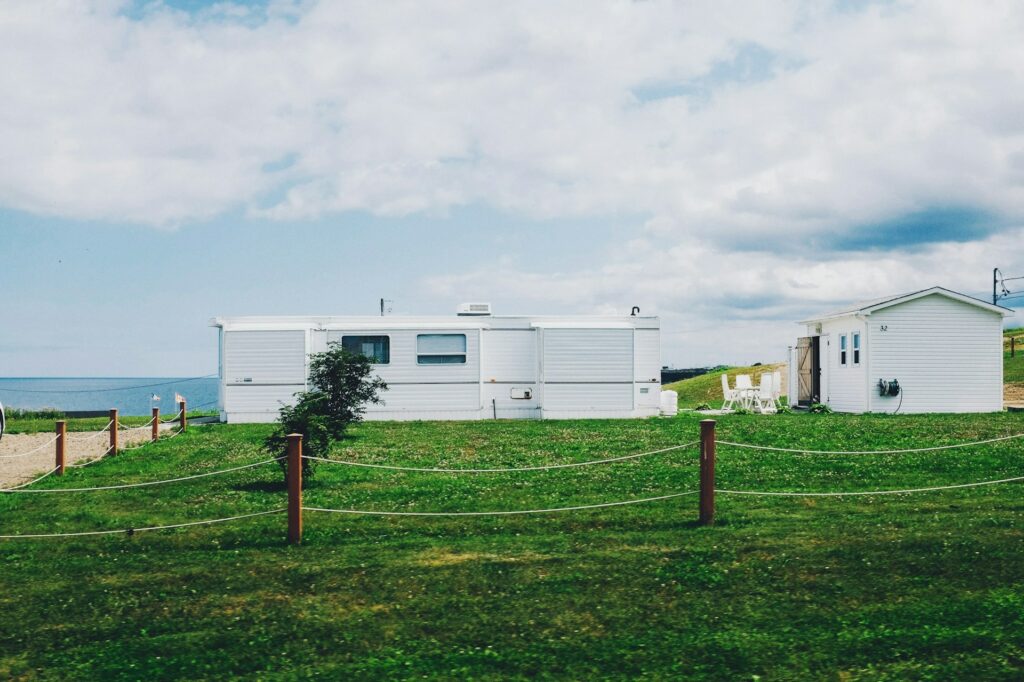Mobile home living offers a unique blend of affordability, flexibility, and comfort. These and other advantages are some reasons why over 20 million Americans opt for mobile homes over traditional residential options.
One crucial aspect often overlooked in mobile homes is the skirting. Skirting enhances the aesthetic appeal and plays a vital function in protecting your home. There are many available types of mobile home skirting, each with its pros and cons.

What Is Mobile Home Skirting?
Mobile home skirting covers the open space between the ground and the bottom of a mobile home. It primarily acts as a protective barrier, shielding the underside of your home from the elements, pests, and debris. Skirting can be made from various materials, offering unique benefits and aesthetic appeal.
Benefits of Skirting Your Mobile Home
Depending on your choice of available mobile home skirting options, you can experience several benefits, including:
- Improved Energy Efficiency: Skirting helps insulate your home, reducing heat loss in the winter and keeping it cooler in the summer. This can lead to significant energy savings.
- Protection from Pests: Skirting is a barrier against rodents and insects that might enter the crawl space under your home.
- Aesthetic Appeal: Skirting provides a finished look to your mobile home, enhancing its overall appearance and potentially increasing its value.
- Structural Support: Proper skirting can provide additional support to the foundation of your mobile home, helping to stabilize it.
- Storage Space: The area enclosed by skirting can be used for storage, providing a secure and weather-protected space for items you don’t want to keep inside your home.
Types of Mobile Home Skirting
Homeowners can choose from different mobile home skirting options to protect the underside of their mobile home. Here are some common options:
1. Vinyl Skirting
Vinyl skirting is one of the most popular choices due to its affordability and ease of installation. Homeowners can find various colors and styles to customize the look of their mobile homes.
Average Cost: $400-$1,200 for a single-wide mobile home, $800-$2,000 for a double-wide mobile home.
Key Features:
- Durability: Resistant to weather conditions and UV rays.
- Flexibility: Can accommodate shifts and movements of the mobile home.
- Maintenance: Easy to clean and maintain.
- Variety: Available in numerous colors and textures.
- Installation: Simple to install.
| Pros | Cons |
|
|
2. Metal Skirting
Metal skirting, often made from aluminum or galvanized steel, is known for its strength and durability. It provides mobile homes with a modern, sleek look.
Average Cost: $500-$2,500 for a single-wide mobile home, $1,000-$5,000 for a double-wide mobile home.
Key Features:
- Strength: Highly durable and long-lasting.
- Weather Resistance: Withstands harsh weather conditions.
- Security: Offers better protection against pests and intruders.
- Aesthetic: Provides a sleek and modern appearance.
- Low Maintenance: Resistant to rust and corrosion.
| Pros | Cons |
|
|
3. Concrete or Stucco Skirting
Concrete or stucco skirting offers a solid and permanent solution. It provides excellent insulation and adds a touch of elegance to mobile homes.
Average Cost: $1,500-$4,500 for a single-wide mobile home, $3,000-$9,000 for a double-wide mobile home.
Key Features:
- Insulation: Provides excellent thermal insulation.
- Durability: Extremely strong and long-lasting.
- Aesthetic: Can be textured and colored to match the home.
- Maintenance: Resistant to pests and weather conditions.
- Value: Can increase the home’s resale value.
| Pros | Cons |
|
|
4. Brick or Cinder Block Skirting
Brick or cinder block skirting offers a classic and durable option. It provides excellent protection and adds significant value to your home.
Average Cost: $2,000-$5,000 for a single-wide mobile home, $4,000-$10,000 for a double-wide mobile home.
Key Features:
- Strength: Extremely durable and sturdy.
- Insulation: Provides good thermal insulation.
- Aesthetic: Classic, timeless look.
- Security: Offers superior protection against pests and intruders.
- Maintenance: Low maintenance once installed.
| Pros | Cons |
|
|
5. Wood Skirting
Wood skirting offers a natural and rustic look. This versatile option can be customized to match the home’s exterior.
Average Cost: $700-$2,000 for a single-wide mobile home, $1,400-$4,000 for a double-wide mobile home.
Key Features:
- Aesthetic: Provides a warm, rustic appearance.
- Customization: Can be painted or stained.
- Insulation: Offers decent thermal properties.
- Ease of Installation: Can be installed with basic tools.
- Availability: Readily available in various types.
| Pros | Cons |
|
|
6. Faux Brick or Stone Skirting
Faux brick or stone skirting provides the appearance of real brick or stone at a fraction of the cost. It is made from high-quality polymers or other synthetic materials.
Average Cost: $1,000-$3,000 for a single-wide mobile home, $2,000-$6,000 for a double-wide mobile home.
Key Features:
- Aesthetic: Realistic brick or stone look.
- Lightweight: Easier to handle and install.
- Durability: Resistant to weather and pests.
- Maintenance: Low maintenance requirements.
- Variety: Available in numerous styles and colors.
| Pros | Cons |
|
|
7. Fiber Cement Skirting
Fiber cement skirting is a durable and versatile option that balances aesthetics and functionality. It is made from a mixture of cement, sand, and cellulose fibers.
Average Cost: $1,500-$4,000 for a single-wide mobile home, $3,000-$8,000 for a double-wide mobile home.
Key Features:
- Durability: Long-lasting, strong materials.
- Weather Resistance: Withstands extreme weather conditions.
- Aesthetic: Can mimic wood, stucco, or stone, which can make it a more cost-effective option.
- Maintenance: Resistant to rot and pests.
- Insulation: Offers decent thermal properties.
| Pros | Cons |
|
|
8. Foam Skirting
Foam skirting is an innovative option that provides excellent insulation. It is lightweight and easy to install, making it a popular choice among homeowners.
Average Cost: $600-$1,800 for a single-wide mobile home, $1,200-$3,600 for a double-wide mobile home.
Key Features:
- Insulation: Superior thermal properties.
- Lightweight: Easy to handle and install.
- Durability: Resistant to moisture and pests.
- Aesthetic: Can be finished to mimic various materials.
- Flexibility: Adapts well to ground shifts.
| Pros | Cons |
|
|
What’s the Best Choice for Mobile Home Skirting?
With plenty of mobile home skirting options, mobile homeowners can choose one that best meets their preferences, budget, and needs. When selecting the best skirting for your mobile home, consider the following factors:
- Budget: Determine how much you are willing to spend, but also consider the long-term costs, as some expensive materials offer more durability in the long run.
- Climate: Consider the weather conditions in your area and whether your skirting is practical for your location.
- Aesthetic Preference: Choose a material that complements your home’s exterior.
- Maintenance: Consider how much upkeep you are willing to do and the costs associated with repairs and maintenance.
- Durability: Choose a material that will last and withstand local conditions.
- Insulation Needs: Consider how much insulation you need. Insulating skirting materials may not be a priority if your mobile already has insulation features.
- Installation: Decide whether you will install it yourself or pay the added costs of hiring a professional.
State Requirements for Mobile Home Skirting
Different states have varying regulations regarding mobile home skirting. Check your local building codes and regulations to ensure your chosen skirting material is compliant. Otherwise, you may have to seek mobile home skirting alternatives. Some states that have requirements for mobile home skirting include:
- Arizona: Vinyl skirting is not allowed, as it can lead to heat expansion and ventilation issues. New homes must undergo a final inspection and receive a permit.
- California: Mobile homes must have cross-ventilation openings of at least 1.5 square feet for every 25 linear feet, including areas under skirted porches. Additionally, wood materials six inches from the ground must be treated.
- New Mexico: Manufactured homes must have non-flammable skirting.
- Oregon: Manufactured homes not resting on a continuous foundation require skirting for the entire home’s undercarriage.
- Washington: The entire home’s perimeter must have non-combustible skirting materials.
Shop for Your Mobile Home Needs at Basic Components
Choosing the right skirting for your mobile home is an important decision. By understanding the options available and considering your specific needs and preferences, you can find the perfect skirting solution that is both functional and visually appealing.
At Basic Components, we supply construction products and supplies for mobile homes. With 30 years of experience, we offer the best online customer service. Shop at Basic Components today—we offer nationwide delivery in the U.S.

